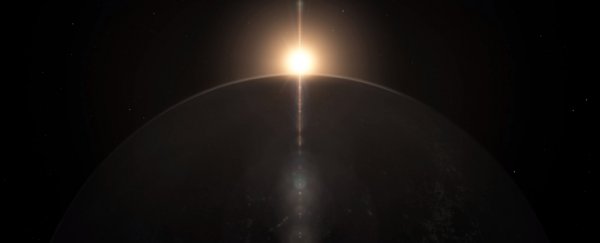Last year, scientists announced the discovery of an exoplanet just 11 light-years (3.37 parsecs) from Earth. Not just any exoplanet - a rocky one, that looks like it might just be habitable. Now another team has taken a closer look, and found evidence that bolsters that supposition.
The planet is Ross 128 b, orbiting a star called Ross 128. And it's this star that was the focus of a new study, led by astronomer Diogo Souto of Brazil's Observatório Nacional.
Using the APOGEE spectrograph at the 2.5-metre Sloan Foundation Telescope at Apache Point Observatory in the US, the researchers analysed the star's near-infrared light to figure out its chemical makeup, using a technique developed by Souto last year.
"Until recently, it was difficult to obtain detailed chemical abundances for this kind of star," he said.
Ross 128 is a red dwarf. Most of the stars in the galaxy are red dwarfs, around 70 percent. They are cooler and smaller than our Sun, and it's estimated that most of them have planets.
Because red dwarfs are so cool, their habitable Goldilocks zone - not too hot, not too cold, but just right for life - is a lot closer than the distance between Earth and the Sun.
However, most red dwarfs are very active. Proxima Centauri, another red dwarf orbited by a rocky exoplanet in the habitable zone, is much closer than Ross 128, but it also belches out so many flares that it's unlikely life could survive on any planets around it.
Ross 128 is the rare inactive red dwarf, with minimal flare activity. This means it's a very good place to look for life - but because of the angle around which Ross 128 b orbits the star, it's difficult to study the planet directly. Looking at the star itself, though, is the next best thing.
"The ability of APOGEE to measure near-infrared light, where Ross 128 is brightest, was key for this study," said astronomer Johanna Teske of Carnegie Institution for Science in the US. "It allowed us to address some fundamental questions about Ross 128 b's 'Earth-like-ness'."
By analysing the star's near-infrared spectrum, the researchers were able to determine how much carbon, oxygen, magnesium, aluminum, potassium, calcium, titanium, and iron it contains.
This, in turn, allows them to understand its planet better. This is because a star's chemical composition affects the protoplanetary disc of dust and gas that swirls around it when it is very young, eventually accreting into planets.
This, in turn, has an effect on the planet's mineral composition and interior structure. For instance, the researchers note in the paper, the amount of magnesium, iron and silicon potentially control a rocky planet's rocky core-to-mantle mass ratios.
Ross 128, as it turns out, has similar iron levels to our Sun. The team wasn't able to determine silicon levels, but they were able to see magnesium content. Equipped with the iron and magnesium levels in the star, the researchers could then estimate the minimum size of the planet's core - and therefore its radius.
They found that Ross 128 b is likely larger than Earth, but still within rocky planet range - that is, not a gas giant.
This radius allowed them to estimate another measurement: how much light and heat is reaching the planet, based on the star's temperature. And looking at those parameters, it's definitely within the star's Goldilocks zone.
There's still so much we don't know, though - for instance, what the planet's magnetic field is like, whether it has an atmosphere, and, if it does, if its weather conditions are hospitable to life. Venus, for example, has an atmosphere, but you'd fry to a crisp before ever reaching the surface.
Nevertheless, the study shows the power of using a star to study planets difficult to view directly. And that we are barking up the right tree with Ross 128 b - at least for now.
"It's exciting what we can learn about another planet by determining what the light from its host star tells us about the system's chemistry," Souto said.
"Although Ross 128 b is not Earth's twin, and there is still much we don't know about its potential geologic activity, we were able to strengthen the argument that it's a temperate planet that could potentially have liquid water on its surface."
The team's research has been published in The Astrophysical Journal Letters.
